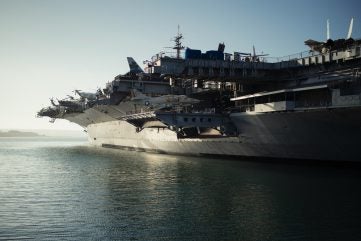
A Littoral OpTech West workshop was held at the Royal Swedish Society of Naval Sciences (KÖMS) in Stockholm in September. Run by the US Littoral Operations Center (LOC), which is part of the US Naval Postgraduate School (NPS), and supported by the US Office of Naval Research Global, with the participation of Swedish defence company Saab, the workshop explored operational and technological challenges in and along the coastal, confined and shallow waters around the globe.
Speaking at the event, Professor Kalev Sepp, director of the LOC, said: “The littoral is where hydrography, geography, commerce, fishing, mining, political boundaries and claims, and military manoeuvres and sustainment issues converge, to complicate both the offence and the defence, and to place exceptional demands on naval, aerial, and land forces that must operate, fight, and influence events there.”
He went on to say that the intent of this workshop, and the further regional events that are planned, was to gather defence leaders and scientists to explore the operational and technological challenges faced by navies in close and confined waters, and in archipelagos:
“Our regional workshops will proceed to different points around the world in order to gather the kind of information we need to optimise maritime operations in these kind of environments, and share the information among partners and allies.”
Swedish Navy Rear Admiral Thomas Engevall, the president of KÖM, added: “For us [in KÖMS], this has been an excellent opportunity to do what we can do best – to provide areas for people to meet and have interesting discussions regarding operations in the littorals, where Sweden has a long experience and we are quite skilled.”
Retired US Navy Rear Admiral Jay Cohen said the meeting covered not only defence but also fisheries, seaborne commerce and even fibre-optic cables.
“More than 90% of all data and communications flow from continent to continent on cables that originate on the continents, go through the littorals, and then run across the deep oceans,” he explained.
Not surprisingly, the attendees concluded that naval dominance in the littoral relies on allies and partners.
“When it comes to ‘jointness’, it is important to understand that this is a matter of ‘combinedness’, which is combined operations together with other nations, their agencies and navies,” said rear admiral Jan Thornqvist, chief of staff of the Swedish Navy.
Bo Wallander, senior director business development naval radars at Saab Electronic Defence Systems, said that the US and Swedish approaches to littoral warfare present two unique yet coupled perspectives.
“The US has been primarily concerned with access via the global commons for brief periods of time, such as during an amphibious assault; the Swedish Navy, while increasingly active in coalition forces around the world, has been primarily concerned with its national existence, while [in the past] operating adjacent to the overwhelming threat of the Soviet Union for decades.”
Expanding on that point, NPS professor Wayne Hughes, a retired US Navy captain, said: “We [the US Navy] are good at ‘blue water’ operations, but we are not that skilled in fighting and operating in the littoral waters in places like the South China Sea, the Baltic and Black Seas as well as the Persian Gulf.
“Coastal waters have not only become increasingly dangerous, but the special region of influence on both sides of a coast is also now much larger. The US Navy needs to understudy fleets like Israel’s, Sweden’s, Norway’s, and others nations who are more practiced fighting in the extreme littorals.”
Sepp agreed: “Our allies have extensive practice in shallow-water operations – we can learn from all of them.”
Sweden’s unique geographical location and thousands of coastal islands has led to the development of technologies by firms such as Saab for very complex littoral environments.
“Saab has been in cooperation with the Swedish Government to develop systems that can operate in this area. We are very glad that we can contribute meaningfully to this workshop together with NPS and KÖMS,” said Saab’s Ted Ackerstierna, head of the company’s naval segment in Western Europe.
A subsequent OpTech East workshop, set in Asia, is being planned for 2015.



